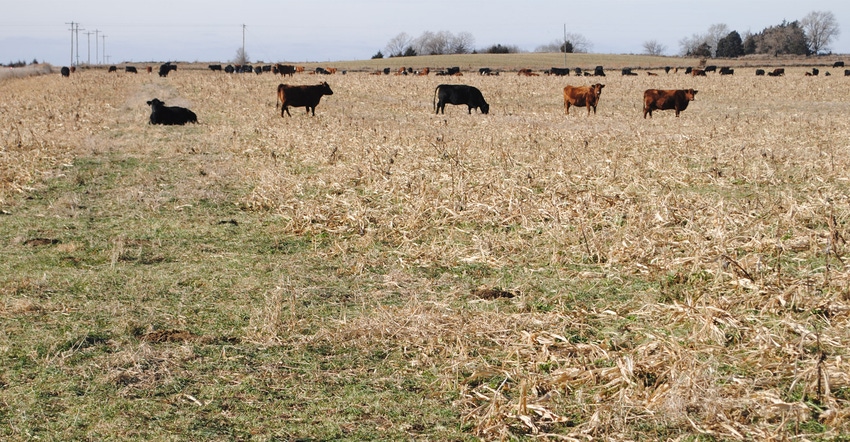
It is safe to say that while farmers are interested in adapting cover crops, questions remain about how to do it without giving up on profit. Interest in cover crops is intense, as evidenced by the first 33 pages in the newly published Nebraska Extension On-Farm 2018 Growing Season Results, where cover crop trials are featured.
“Some of the big questions are how to implement and manage cover crops in such a way to see benefits to soil while maintaining profitability,” says Laura Thompson, Nebraska Extension educator and On-Farm Research Network coordinator. “Some growers, especially those where available water for the subsequent cash crop is a concern either due to lack of irrigation or restrictions on irrigation, are trying to figure out how to implement cover crops without negatively impacting crop yields. Others are looking at various aspects such as establishment of the cover crop.”
These concerns lead to related questions about how early a cover crop can get established and what methods are available to interseed cover crops into a standing corn crop, for instance.
Farmers are asking if they can plant a shorter season crop that can be harvested earlier and allow establishment of a cover crop earlier, Thompson says. There also are questions about fertility management on subsequent crops and what types of fertilizer should be used and the timing of fertilizer applications.
Thompson says farmers want to know about termination timing and if they can plant into a green cover crop. “These are all questions that I have heard from producers, and many are attempting to address through on-farm research,” she adds.
Getting the timing of cover crop planting right is crucial.
“There are several strategies producers are trying,” Thompson says. “One of those is planting shorter season corn and soybeans. In our on-farm research network, growers have been evaluating their yields when they plant a shorter season hybrid or variety.
“The goal is to determine if they can use a shorter season variety without losing yield, to allow more time to establish cover crops in the fall.”
There is variation in the results because of genetics and growing conditions.
“This is one option producers might want to evaluate in their own growing environment and with their preferred genetics,” she says.
“Probably the most consistent way we have seen cover crops work well is in a more diversified system where the cover crop or forage is able to be grazed,” Thompson says. “For some growers who have cattle, this is a very natural fit.”
For those without cattle, it might be feasible to form partnerships with neighbors with cattle to better use cover crops and fit them into the system, she adds.
With a record number of cover crop studies in the on-farm network in 2018, researchers are looking forward to this season to gain a better understanding of how to implement cover crops.
“We are open to a variety of research topics, and we encourage producers to evaluate aspects that are important to them,” Thompson says. “For some, that may be evaluating two different times of cover crop termination. For others, it may be evaluating nitrogen rates following cover crops. Those who have been using cover crops for some time may be interested in evaluating different mixtures and documenting soil changes over time.”
For first-time cover croppers, there are a couple of treatments that would make good starting point.
“Try with and without a rye cover crop, randomized and replicated several times in their field,” Thompson suggests. “We would encourage these growers to maintain the ‘with and without’ cover crop strips for several years in the same place to better document the long-term impacts.”
This can easily be done with GPS.
“Producers should capture the yield data for the crop following the ‘with and without’ rye treatments,” she says. “They should also collect other information, like cover crop biomass and soil organic matter.”
Researchers encourage farmers to take photos and even obtain aerial imagery of the fields being studied to help document cover crop establishment and the differences in cash crops following cover crops.
“By keeping the strips in place over a longer period, it helps us capture long-term differences, which is often difficult to do,” Thompson says. “This is a great starting point for those who are interested in learning more and evaluating cover crops on a smaller scale before diving in with their whole operation.”
“If you look at multiyear data, soybeans planted after cereal rye rarely shows a yield penalty,” Nebraska Extension educator Keith Glewen says. “Corn following cereal rye is not as consistent.”
With profit margins strained, profitability and the relationship with the banker drive the system, Glewen says.
“At the same time, we have growers who are looking at incorporating on-farm research to see if all this hype about cover crops is for real,” he says. “In addition, some growers are concerned about the impact of today’s agriculture system on their soil resources. This, in itself, is a great reason for their investment in conducting research relating to cover crops.”
Diversification outside of a simple corn-soybean rotation, having center pivot irrigation and cattle seem to be winning components to a cover crop strategy, Glewen adds.
For those interested in setting up cover crop on-farm studies, contact your local Nebraska Extension educator, Thompson or Glewen for information. Learn more online at cropwatch.unl.edu/on-farm-research.
About the Author(s)
You May Also Like






